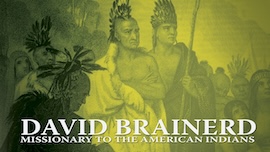Friedrich Crämer Was a "Living Book" to Indians at Frankenmuth
WHEN THE LUTHERAN CHURCH in Germany appealed for Lutheran missionaries and ministers to go to the American frontier, Friedrich August Crämer answered the call. Born in Klein-Langheim, Bavaria in 1812, Cramer was arrested while a university student at Erlangen for his involvement in a plot to start a revolution. He went to prison a radical social activist but emerged a Christian, reasoning, “If Christ has redeemed lost and condemned sinners, then He has redeemed me also; because everything in me and in my life is lost...”
Pastor Wilhelm Loehe recruited German families to form a mission settlement in Michigan and become a “living book,” showing Native Americans what it was like to live with Christ as savior. He selected Crämer, a theology student, as their pastor.
In 1845, the Lutheran immigrants settled in Saginaw Valley, where they battled mosquitoes and broke ground for a town they named “Frankenmuth” (Courage of Franconia). They erected a few log cabins before winter, helped their pastor and his wife construct a place to live, and cleared land for next spring’s planting.
As soon as he could do so, Crämer began teaching Indian children, assisted by Jim Grant, his interpreter, who was half Chippewa. In time, he baptized thirty-one Indians. Although Crämer taught from his own home, he also visited the Chippewa Indians in their villages and ate their food with them. When the local Indians succumbed to western diseases, Crämer extended his work by building three mission stations, one at a distance of seventy miles. He visited each of these every month regardless of weather or his own state of health.
During 1846, close to one hundred additional German immigrants swelled Frankenmuth’s population. Up to this time, the community had been worshiping in the Crämer living room. Now it was apparent a church was needed. The settlers erected St. Lorenz Lutheran Church and dedicated it on Christmas Day. The date of dedication was appropriate, for Christmas would become a major day for Frankenmuth—which much later would call itself the Christmas capital of the world, with Christmas stores, restaurants, and retreats that stayed open year-round.
The Indian mission folded as the Indians migrated westward. Theological difficulties also arose when Lutherans teaching other, less-confessional doctrines arrived. To counter this, Crämer helped found the Lutheran Church—Missouri Synod and taught in its seminaries. His hearers considered him an excellent teacher. While teaching in St. Louis, he organized a congregation of Irish and German immigrants whom he served without pay as their church grew to over three hundred members. In 1881, he lost three of his grown children and two grandchildren. His wife’s health declined from the shock and in 1884 she died as well.
Unable to support its own growth, the seminary in St. Louis eventually split. Part of the seminary moved to Illinois, and Crämer led the move despite his age. He continued to work himself relentlessly, and as a result, his health gave way. The Lutheran Witness of May 7, 1891 reported: “It is our sad duty to chronicle the bereavement of our synod and the Springfield Seminary by the demise of Rev. Prof. A. Crämer, late senior professor of our synod and president of our Concordia Seminary, Springfield, Ill. ... he had been suffering from a severe attack of the grippe [influenza], and fell asleep in Jesus on the 3rd of May at 3.50 A.M.” Altogether, he had prepared six hundred and thirty five candidates for ministry.
—Dan Graves
----- ----- -----
A century before Crämer, David Brainerd was also a Missionary to American Indians. Watch at RedeemTV.
David Brainerd: Missionary to the American Indians can be purchased at Vision Video







